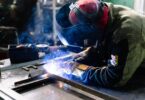How to become a bladesmith: bladesmithing is the art of creating knives, swords, and other edged weapons using traditional blacksmithing techniques.
It is a rewarding and challenging hobby that allows you to create beautiful, functional tools and weapons.
This guide will walk you through the steps of becoming a bladesmith. This will include the tools and equipment, techniques, and safety precautions.
SEE ALSO: How to Start A Lice Removal Business
How to Become a Bladesmith: Tools and Equipment
When it comes to bladesmithing, having the right tools and equipment is essential. Here is a list of some of the basic tools that you will need to get started:
Anvil
An anvil is a large, heavy metal block used to shape and hammer steel. It is the foundation of bladesmithing and is where most of the work is done.
A good quality anvil should be made of cast steel and have a hard surface, such as a hardened steel plate.
It should also have a variety of differently shaped surfaces, such as a round horn, a square horn, and a flat surface.
Forge
A forge is used to heat the steel to be worked on. It is typically made of a firepot, where the fire is contained, and a chimney to allow the smoke and heat to escape.
Different types of forges are available, such as coal forges, gas forges, and propane forges.
Each type has its advantages and disadvantages, so choosing the one that best suits your needs is important.
Hammer
A hammer is used to shape the steel. Different hammers are available, such as cross-peen hammers, rounding hammers, and straight-peen hammers.
Each type of hammer is used for different purposes, so it is important to have various hammers.
Tongs
Tongs are used to hold the steel in place while it is being worked on. They are an essential tool for bladesmithing, allowing you to handle hot metal safely.
Different types of tongs are available, such as flat jaw tongs, round jaw tongs, and offset tongs.
Each type of tong is designed for different types of work, so it is important to have various tongs.
Grinders
Grinders are used to smooth and finish the steel. They come in different types, such as bench grinders, belt grinders, and angle grinders.
Each type of grinder has its own advantages and disadvantages, so it is important to choose the one that best suits your needs.
Optional tools
In addition to the basic tools, there are also many optional tools that you may want to invest in, such as a drill press, belt sander, and power hammer.
A drill press makes precise holes in the steel, while a belt sander is used to smooth and finish the steel.
A power hammer is a large, mechanized hammer that can shape steel quickly and efficiently.
It’s also important to mention that apart from the tools, you will also need a workspace with a sturdy workbench, good lighting, and enough space to move around.
As bladesmithing is messy and dirty, it’s essential to have a clean and organized workspace to work efficiently.
SEE ALSO: How To Become A Call Boy
How to Become a Bladesmith: Materials
1. Steel
When it comes to bladesmithing, the most important material is steel. Steel is a strong, durable, and flexible metal that is well-suited for creating knives, swords, and other edged weapons.
However, not all steel is created equal, and it’s important to understand the available steel types and their best uses.
Here are a few types of steel that are commonly used in bladesmithing:
Tool Steel
Tool steel is another popular choice for bladesmiths, as it is strong and easy to work with. It is a high-strength steel that is resistant to wear and abrasion.
Tool steel is known for its ability to hold a sharp edge and its resistance to deformation.
However, it is also more expensive than other types of steel.
High Carbon Steel
High carbon steel is a strong and durable steel often used for knives and swords. It is made by adding carbon to iron, which makes it harder and more brittle.
High carbon steel is known for its ability to hold a sharp edge and its resistance to wear.
However, it is also more prone to rust and corrosion if not properly maintained.
Stainless Steel
Stainless steel is resistant to rust and corrosion, making it a good choice for knives and other tools used in wet or damp environments.
This steel is made by adding chromium to steel, creating a chromium oxide layer that protects the steel from rust and corrosion.
However, it is not as strong or durable as high-carbon or tool steel.
2. Wood
In addition to steel, you will also need other materials, such as wood for the handle and leather for the sheath. The type of wood and leather you use will depend on your personal preferences and the design of the knife or sword.
When it comes to the wood handle, you have many options, from hardwoods like oak or hickory to softer woods like walnut or cherry.
Each type of wood has its own unique characteristics, such as weight, density, and color, so it’s important to choose a wood that is well-suited for the knife or sword you are making.
3. Leather
As for the leather sheath, you can choose from different types of leather, such as cowhide, buffalo hide, or even exotic leather like stingrays or sharks.
It’s also worth mentioning that different alloys and steels are available, such as Damascus steel, a mixture of different steels folded and welded together to create a unique pattern. It’s often used for decorative knives and swords.
How to Become a Bladesmith: Techniques
Bladesmithing involves several techniques, including forging, grinding and sanding, heat treating, and finishing.
Forging is heating the steel and then shaping it using a hammer.
Grinding and sanding are used to smooth and finish the steel.
Heat treating is the process of heating and cooling the steel to change its properties and make it stronger and more durable.
Finishing is the final step in the bladesmithing process and involves polishing, etching, and engraving the steel.
Safety Tips for Bladesmith
Bladesmithing can be a dangerous hobby if proper safety precautions are not taken. Always wear personal protective equipment (PPE) such as gloves, eye protection, a face shield, and a respirator.
Safety precautions include proper ventilation, proper handling of tools, and proper handling of hot metal.
How to Become a Bladesmith: Practice and Training
To become a skilled bladesmith, it is important to practice regularly and learn from experienced bladesmiths.
Finding a mentor or joining a bladesmithing community can be a great way to learn new techniques and get feedback on your work. Attend bladesmithing workshops, classes, and events.
SEE ALSO: How to Become an Online Casino Agent
Conclusion
Bladesmithing is a rewarding and challenging hobby that allows you to create beautiful and functional knives, swords, and other edged weapons.
By following this guide, you can learn the necessary tools and equipment, the techniques and materials to use, and the safety precautions to take.
With practice and training, you can become a skilled bladesmith and create beautiful and functional knives, swords, and other tools for yourself and others.






